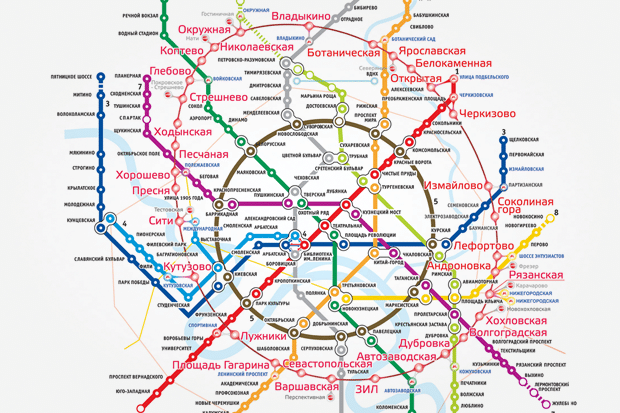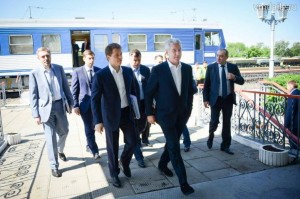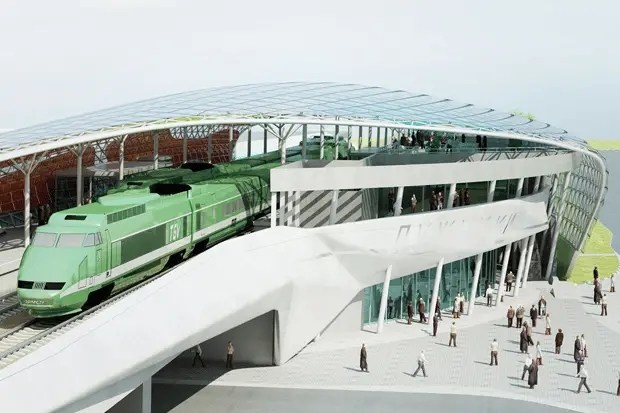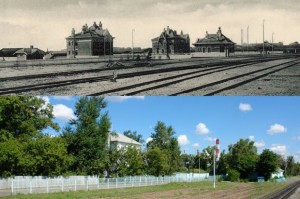The Village is a Russian-language publication in Moscow, St. Petersburg, and Kiev that seeks to inform locals about their various cities, upcoming events, urban changes, and history. One of the truely exciting things occurring in Russia today is the amount of infrastructure projects currently underway – long-distance railways, roads, and major changes to public transportation in many cities. This article has been translated for the first time into English by SRAS Translate Abroad Scholar scholar Caroline Barrow. Read the original Russian here.
Coming Soon:
The Moscow Ring Railway
By 2015, the Moscow Ring Railway should begin moving passengers in Moscow. It was built in the beginning of the twentieth century, but has been used so far only to transport cargo. The Village found out where the project stands and what the ring should look like when completed.
Objective 1
The Moscow Ring Railway should unify Moscow’s various transport systems. It should be integrated with the metro, giving passengers yet another circle line to use to transfer between lines and thus clearing congestion in the center of the metro. The Moscow Ring Railway and the Moscow Metro will be connected in one system with one ticket. Transferring from one to the other will be free.
Timur Bashkaev,
Head Architect of the Moscow Ring Railway Corporation
When the Moscow Ring Railway was being built, there was not even talk about the subway. Where the Ring was built was entirely industrial, so there was no need to build a subway there. Because of this, nowhere are the railway stations and subway stations close to each other. If subway stations are near the railway, this is just a coincidence. Where it is possible, we will move the railway terminals closer to the stations. We have designed it so that the distance between the two is between 275-325 yards. The longest distance to walk between the two will be 875 yards.
In some areas, the Moscow Ring Railway overlaps the proposed second metro circle line, currently under construction. However, the Moscow Ring Railway is in the shape of an egg pointed north, and the subway ring will be like an egg pointed south. Moreover, on this map the distance between the two rings looks not very big, but in reality the distance is several kilometers.

The new metro ring line and the Moscow Ring Railroad will be integrated systems to speed Moscow’s public transporation. The path of the Ring Railroad is shown here with fainter, straight lines.
Objective 2
The Moscow Ring Railway will connect with the commuter trains which travel to Moscow’s suburbs and which spoke out from the city center in a wheel formation. People traveling from Moscow to the suburbs won’t need to travel to the city center to connect to their destination subway line. The Moscow Ring Railway will also connect all the commuter trains lines in a ring. It is still unclear if the commuter trains will also be combined with single-ticket system for the subway and ring railway.
Alexei Zotov
First Deputy/Assistant to the General Director of the Moscow Ring Railway Corporation
Development of the Moscow Ring Railway would have been impossible without the development of the commuter trains. A decision about the trains’ timetable was made not long ago, to emphasize reducing the intervals between train arrival times and the number of service breaks for trains traveling in every direction. (Now, passengers and freight can travel on the same rails at the same time.) In light of this, launching the Moscow Ring Railway is all the more important.
As with the subway, we will move some Ring railway stations so that transfers between commuter trains will be more convenient. After the addition of the timetable and launch of the Ring, our system will be similar to Berlin’s mass transit system.
Objective 3
The Moscow Ring Railway runs through largely industrial areas of Moscow, located between the center and outer suburbs. With the appearance of this major new transport route, this now under-used area will receive a boost in development.
Timur Bashkaev: “Developing this industrial area is of course not a task of the Moscow Ring Railway. We do not do development work; we will only do the first step—bringing in a modern transportation system. But, we hope that a revitalization of this area will follow, as it is currently in a terribly depressing state.
What now?
Roads and Stations
The Moscow Ring Railway is currently two railway tracks, both used for transporting cargo. By 2015, a third track will be added around the entire ring. One track will be used for cargo transportation to meet the needs of industries that still operate there and the two others will be used exclusively for passengers. The train will move with minimal intervals, which will run as low as five-minutes at rush hour.
New routes for aboveground public transportation are currently being developed to make it easier to reach the ring stations. Next to every transportation hub, there will be parking lots and bus hubs. The first four stations are designed, and one of them— Leninsky Prospect, currently has the bare concrete structure complete – the finishing touches will be added soon. Also soon, construction on Luzhniki Station will begin. Simultaneously, the Moscow Ring Railway will be electrified (currently, the trains there run on diesel.)
Trains
Railway vehicles will be designed specifically for the Moscow Ring Railway. Foreign equivalents are not suitable due to different track-widths, and in Russia there are simply not trains that suit the needs of the Ring.
Alexei Zotov: “Trains should be functionally similar to the subway trains: passengers should be able to embark and disembark in not more than 30 seconds. Otherwise, it may take up to 2.45 hours to travel the ring, and we foresee the entire route taking 45 minutes.
The interior of the wagons will be similar to those on the subway. Trains will be fitted to carry goods and bicycles. Another important requirement is the ability to walk between the wagons. We have prepared the specifications and have received several offers from foreign and Russian companies, but still have not chosen a contractor to construct the wagons.”

Mayor Sobyanin at the Moscow Ring Railway. Transportation has been one of his stated priorities since the beginning of his tenure as mayor.
Cultural Legacy
Famous architects designed and constructed the majority of stations in the 20th Century – before the Moscow Ring Railway was formed. Many of these buildings still stand, largely because the Moscow Ring Railway was a closed off from ordinary people and these stations were not of interest to investors. Now, cultural heritage experts are studying these stations and establishing conservation zones for each.
Irina Krimova
Director of Mosproekta-2 Studio #20
We plan to use the stations within the new project, but they are very diverse. The majority has been preserved very well but do not fit modern transportation needs. However, we hope that they can find some use. It would be awesome to enjoy these old buildings while riding the trains. There are also old warehouses and small buildings where station workers lived. In general, the territory of the Moscow Ring Railway is currently a very curious scene. For the most part, they are abandoned or surrounded by factories and industrial plants, but in some places, you can observe what a typical Moscow suburb looked like at the beginning of the 20th century.
Alexei Zotov: “Part of the historical buildings will be used for administrative needs. But a large part of them passengers will never see. In many places, the platforms will have to be moved, and nobody will transfer the buildings, of course. As requested by local residents, we will also have to install noise-barriers virtually the entire length of the railway which will also hide the stations from sight.”
Read the original Russian here and see lots more pictures!




